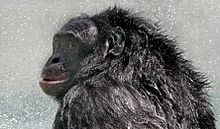用户:Sdtddh/沙盒
| 坎兹 | |
|---|---|
 Kanzi in 2005 after a shower | |
| 出生 | 1980年10月28日 乔治亚州立大学 |
| 知名于 | 懂得使用符号字 |
| 亲属 | Lorel (mother) Panbanisha (sister) Nyota (nephew) Nathen (nephew) Elikya (sister) Maisha (brother) Teco (nephew) |




坎兹 (出生于1980年10月28日),耶基斯语名:![]() (源于中文字:太),是一只雄性黑猩猩
(源于中文字:太),是一只雄性黑猩猩
, is a male bonobo who has been the subject of several studies on great ape language. According to Sue Savage-Rumbaugh, a primatologist who has studied the bonobo throughout her life, Kanzi has exhibited advanced linguistic aptitude.[1][2][3]
Biography
[编辑]卡兹出生于埃默里大学
卡兹出生后不久就被Matata领ㄧ
Born to Lorel and Bosandjo at Yerkes Field Station at Emory University and moved to the Language Research Center at Georgia State University. Shortly after birth Kanzi was stolen and adopted by a more dominant female, Matata, the chief leader of the group. Kanzi and his sister (Matata's offspring, now deceased) moved to the Ape Cognition and Conservation Initiative (ACCI),[4] formerly the Great Ape Trust, in Des Moines, Iowa, where Kanzi is the highest ranking male of the resident community of bonobos.
As an infant, Kanzi accompanied Matata to sessions where Matata was taught language through keyboard lexigrams, but showed little interest in the lessons. It was a great surprise to researchers then when one day, while Matata was away, Kanzi began competently using the lexigrams, becoming not only the first observed ape to have learned aspects of language naturalistically rather than through direct training, but also the first observed bonobo to appear to use some elements of language at all.[2][3] Within a short time, Kanzi had mastered the ten words that researchers had been struggling to teach his adoptive mother, and he has since learned more than two hundred more. When he hears a spoken word (through headphones, to filter out nonverbal clues), he points to the correct lexigram.[2][3]
According to a Discover article, Kanzi is an accomplished tool user.[5]
Kanzi's adoptive mother, Matata, lived to be one of world's oldest captive bonobos until her death in June 2014.[6] In the matriarchal society of bonobos, a male's position is primarily determined by the position of the females he is related to. Matata was the group's chief leader so his status as the highest ranking male was established by being adopted as her "son". According to the Smithsonian magazine, Kanzi "has the mien of an aging patriarch – he's balding and paunchy with serious, deep-set eyes."[7] This description is confirmed by a full-page color photograph of Kanzi in the March 2008 National Geographic, and a full-page black-and-white photograph in Time magazine.[8]
行为与能力
[编辑]卡兹的的行为与能力是科学期刊上的研究主题,也受大众媒体报导与关注。
研究计划
[编辑]当卡兹8岁时,他被纳入一个为时九个月的研究计划。计划里他与一个2岁的人类小孩阿里亚(Alia)作为受试者,测试对于口头指令的反应。卡兹与阿里亚总共被给予660个口头指令,使用熟悉的物体进行一些不同的任务。测试结果卡兹正确执行了74%的任务,阿里亚正确执行了65%的任务。[9][10]
另一个由考古学家凯西·希克(Kathy Schick)与尼古拉斯·托斯(Nicholas Toth)发起的研究里,研究卡兹对于早期石器时代的工具的认知与制作能力,并且与人类祖先(能人)比较。这些工具包括 计划里,希克与托斯向卡兹展示如何敲打石头,制造锐利的边缘,并用来切断绳子拿到奖励。在各种场合示范了这些过程后,研究人员将食物放在有透明盖子的盒子里,然后用一根绳子绑起来,然后将卡兹引导到放置盒子的围栏里,并给予必要的石头(燧石)。在多年的研究里,卡兹不仅学会用打制石片器,他还想出往坚硬物体扔鹅卵石的方式制造石片器。懂得制作石片器后,卡兹能取得盒子里的食物。不过与早期石器时代的人类相比,他制造与使用的石器较为粗糙。[11][12][13]
轶事
[编辑]以下是关于卡兹的轶事。
- 在一次树林的郊游里,卡兹碰触了代表"棉花糖"和"火"的符号。苏珊·萨维奇·朗博在接受采访时说"在拿到火柴与棉花糖后,卡兹折断树枝,用火柴生火,并用木棍烤棉花糖。"[14] 在《电讯报》有刊登卡兹生火煮食的照片。[15]
- 苏珊请保罗·拉斐尔为倭黑猩猩们表演哈卡舞,这种毛利人的战斗舞蹈包括拍击大腿、击胸与叫喊。几乎所有倭黑猩猩将这些行为视为侵略性的表现,并且反应出大叫、露出牙齿与敲打墙壁和地板等行为。卡兹则保持冷静,并且用倭黑猩猩发音与苏珊沟通。苏珊对保罗说"他(卡兹)希望你可以为了他再表演一次,这次在外面的房间,这样其他的倭黑猩猩才不会生气。"之后,保罗在另一间房间里重新进行了一次表演。[14]
- 苏珊曾经看过卡兹与他的姊妹潘班尼沙(Panbanisha)沟通。在这个实验里,卡兹被关在一个独立房间,房里有一些优格。卡兹发出一些潘班尼沙能听到的声音,潘班尼沙虽然看不到优格,但却能指出代表优格的符号字。这代表卡兹发出的声音可能并非无意义的。[14][16]
- 在一次电视节目(Champions of the Wild)里[17],展示了卡兹游玩并了解如击败何街机游戏吃豆人。
语言
[编辑]除了使用符号字键盘进行沟通,坎兹还透过大猩猩可可的影片学会美式手语。苏珊一开始并不知道坎兹会用手语,直到坎兹使用手语向人类学学家丹·普林斯·休斯表达"你,大猩猩,问题",曾与大猩猩合作过的丹才发现坎兹会用手语。[18]根据耶克斯灵长类动物研究中心的测试,坎兹识别手语的准确度有89-95%。[19]
由于倭黑猩猩的声带与人类不同,坎兹无法发出很多人类的声音,也无法用多数人能理解的方式讲话。尽管如此,当坎兹在与人类用图形符号沟通时,他还是会试着发出一些声音。后来发现他发出的声音就是他指的图形符号,只是发出的声音较高且不准确。[20]

根据博士苏·萨维奇·朗博的研究,卡兹能够"了解个别单字的意思,并且能理解它们在新句子里的意思"。比如说,研究者要卡兹去拿微波炉里的红萝卜,卡兹会忽略身边的红萝卜,直接去找微波炉里的红萝卜。"[21]又比如研究者给卡兹任务,要求"给你的球喂食番茄",卡兹选了一颗万圣节南瓜海绵玩具当作"球",并将番茄放在玩具的嘴上。与之相较,2岁的儿童不知道如何执行任务。[22][23]
See also
[编辑]- Ape language
- Evolution of language
- Human Ape, a National Geographic documentary film
- Yerkish
Other animals used in language studies:
References
[编辑]- ^ Kluger, Jeffrey. Inside the Minds of Animals. Time. August 5, 2010 [December 13, 2014].
- ^ 2.0 2.1 2.2 Savage-Rumbaugh, S., & Lewin, R. Kanzi: The Ape at the Brink of the Human Mind. Wiley. 1994. ISBN 978-0-471-58591-6.
- ^ 3.0 3.1 3.2 Mitani, J. Kanzi: The Ape at the Brink of the Human Mind. Scientific American. 1995, 272 (6). ISSN 0036-8733.
- ^ ACCI: Ape Cognition & Conservation Initiative. apeinitiative.org. [2016-03-08].
- ^ Ape at the Brink. Discover. September 1994.
- ^ Finney, Daniel. Bonobo Matata dies at Des Moines ape conservation. The Desmoines Register. June 22, 2014 [27 June 2014].
- ^ Raffaele, Smithsonian, November 2006.
- ^ Time, August 16, 2010.
- ^ Savage-Rumbaugh, E. Sue. Language Comprehension in Ape and Child. Monographs of the Society for Research in Child Development. 1993, 58 (3 to 4): i–252. CiteSeerX 10.1.1.473.9931
 . JSTOR 1166068. doi:10.2307/1166068.
. JSTOR 1166068. doi:10.2307/1166068.
- ^ Harris, Margaret; Butterworth, George. Developmental Psychology: a Student's Handbook. Psychology Press. 2012: 178 to 180. ISBN 9781135844677.
- ^ Schick, K. D., Toth, N., Garufi, G., Savage-Rumbaugh, E. S., Rumbaugh, D., & Sevcik, R. (1999). Continuing Investigations into the Stone Tool-making and Tool-using Capabilities of a Bonobo (Pan paniscus). Journal of Archaeological Science, 26(7), 821-832.
- ^ Savage-Rumbaugh, Sue; Lewin, Roger. Kanzi: the Ape at the Brink of the Human Mind
 . John Wiley. 1994: 201 to 222. ISBN 978-0471159599.
. John Wiley. 1994: 201 to 222. ISBN 978-0471159599.
- ^ Toth, Nicholas; Schick, Kathy D.; Savage-Rumbaugh, E.Sue; Sevcik, Rose A.; Rumbaugh, Duane M. Pan the Tool-Maker: Investigations into the Stone Tool-Making and Tool-Using Capabilities of a Bonobo (Pan paniscus). Journal of Archaeological Science. January 1993, 20 (1): 81–91. doi:10.1006/jasc.1993.1006 (英语).
- ^ 14.0 14.1 14.2 Raffaele, P. Speaking Bonobo. Smithsonian. November 2006 [2008-03-18].
- ^ Amazing photos of Kanzi the bonobo lighting a fire and cooking a meal. The Daily Telegraph. December 30, 2011.
- ^ Savage-Rumbaugh, Sue; Fields, William M.; Spircu, Tiberu. The emergence of knapping and vocal expression embedded in a Pan/Homo culture (PDF). Biology and Philosophy. 2004, 19 (4): 541–575. doi:10.1007/sbiph-004-0528-0.
- ^ Season 4, Episode 3. Screened 10/30/2000
- ^ Prince-Hughes, Dawn. Songs of the Gorilla Nation
 . Harmony. 1987: 135. ISBN 978-1-4000-5058-1.
. Harmony. 1987: 135. ISBN 978-1-4000-5058-1.
- ^ Williams, S.L. Comprehension Skills of Language-Competent and Nonlanguage-Competent Apes.. Language and Communication Journal. 1997, 17 (4): 301–317. doi:10.1016/S0271-5309(97)00012-8.
- ^ Greenspan, S. I., and S. G. Shanjer. 2004. The first idea: How symbols, language and intelligence evolved from our primate ancestors to modern humans. Da Capo Press.
- ^ "Chimp matches 2-year-old Cognitive capabilities more like humans' than experts believed." Globe & Mail [Toronto, Canada], April 6, 1991, A11. Opposing Viewpoints in Context (accessed December 1, 2018). http://link.galegroup.com.librarynt.occc.edu/apps/doc/A164263203/OVIC?u=okccc_main&sid=OVIC&xid=ca8f20a0.
- ^ Wise, Steven M. "Why Animals Deserve Legal Status." Higher Education, February 2, 2001, B13. Quoted in "Animals Deserve Legal Rights." Animal Rights, edited by Shasta Gaughen. Contemporary Issues Companion. San Diego, CA: Greenhaven Press, 2005. Opposing Viewpoints in Context (accessed December 1, 2018). http://link.galegroup.com.librarynt.occc.edu/apps/doc/EJ3010344210/OVIC?u=okccc_main&sid=OVIC&xid=e0a8a0ce.
- ^ Neurophilosophy and Alzheimer's Disease,該實驗的相關敘述與圖片.
Further reading
[编辑]- Joseph, John E., Nigel Love & Talbot J. Taylor (2001). Landmarks in Linguistic Thought II: The Western Tradition in the 20th Century (London & New York: Routledge), chapter 15: "Kanzi on Human Language".
- de Waal, Frans (2005). Our Inner Ape, ISBN 1-57322-312-3.
- Raffaele, Paul (2006), "The Smart and Swinging Bonobo", Smithsonian, Volume 37, Number 8 (November 2006—a general article about bonobos).
External links
[编辑]- 60 Minutes Australia Talk to the Animals October 2011 featuring Kanzi
- YouTube上的Kanzi recognizing the symbols of the lexigram
- The Gentle Genius of Bonobos, TED talk in part about Kanzi
- Video documentary site by Sue Savage-Rumbaugh containing a documentary featuring Kanzi
- Speaking Bonobo article at the Smithsonianmag webpage
